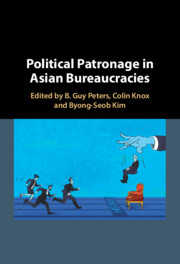Book contents
- Political Patronage in Asian Bureaucracies
- Political Patronage in Asian Bureaucracies
- Copyright page
- Contents
- Figures
- Tables
- Contributors
- Abbreviations
- 1 Patronage in Asian Political Systems
- Part I One-Party Dominated Systems
- Part II Two-Party/Multi-Party Systems
- 5 Patronage Appointment in Japanese Politics
- 6 Patronage in Mongolia
- 7 Loyalty or Expertise? The Practice of Political Patronage in Taiwan
- 8 Political Appointments in South Korea
- 9 Patronage Appointments in the Philippine Public Service
- Part III Autocracies
- Index
- References
8 - Political Appointments in South Korea
from Part II - Two-Party/Multi-Party Systems
Published online by Cambridge University Press: 05 October 2023
- Political Patronage in Asian Bureaucracies
- Political Patronage in Asian Bureaucracies
- Copyright page
- Contents
- Figures
- Tables
- Contributors
- Abbreviations
- 1 Patronage in Asian Political Systems
- Part I One-Party Dominated Systems
- Part II Two-Party/Multi-Party Systems
- 5 Patronage Appointment in Japanese Politics
- 6 Patronage in Mongolia
- 7 Loyalty or Expertise? The Practice of Political Patronage in Taiwan
- 8 Political Appointments in South Korea
- 9 Patronage Appointments in the Philippine Public Service
- Part III Autocracies
- Index
- References
Summary
This chapter provides a brief account of political appointments in the South Korean government, with a particular attention to presidential appointments. We also demonstrate why appointments of cabinet ministers warrant further scholarly attention. Then, we assess presidential appointments of ministers in an empirical manner. In the analytical section of the chapter, we first describe in detail how we have constructed a novel dataset. In presenting the analysis results, we first describe major demographic characteristics of the country’s past cabinet ministers and illustrate their major career paths prior to their ministerial appointments. We also categorize the past appointments into the six types of political patronage per Peters’ typology. Our findings reveal that, in South Korea, programmatic technocrats are the dominant group of presidential appointees regardless of regime and ministry. Among those programmatic technocrats, nearly half are former bureaucrats. Our findings also suggest that, while the vast majority of the South Korean ministers are programmatic technocrats, there are some notable differences across regimes and ministries.
Keywords
- Type
- Chapter
- Information
- Political Patronage in Asian Bureaucracies , pp. 183 - 198Publisher: Cambridge University PressPrint publication year: 2023



